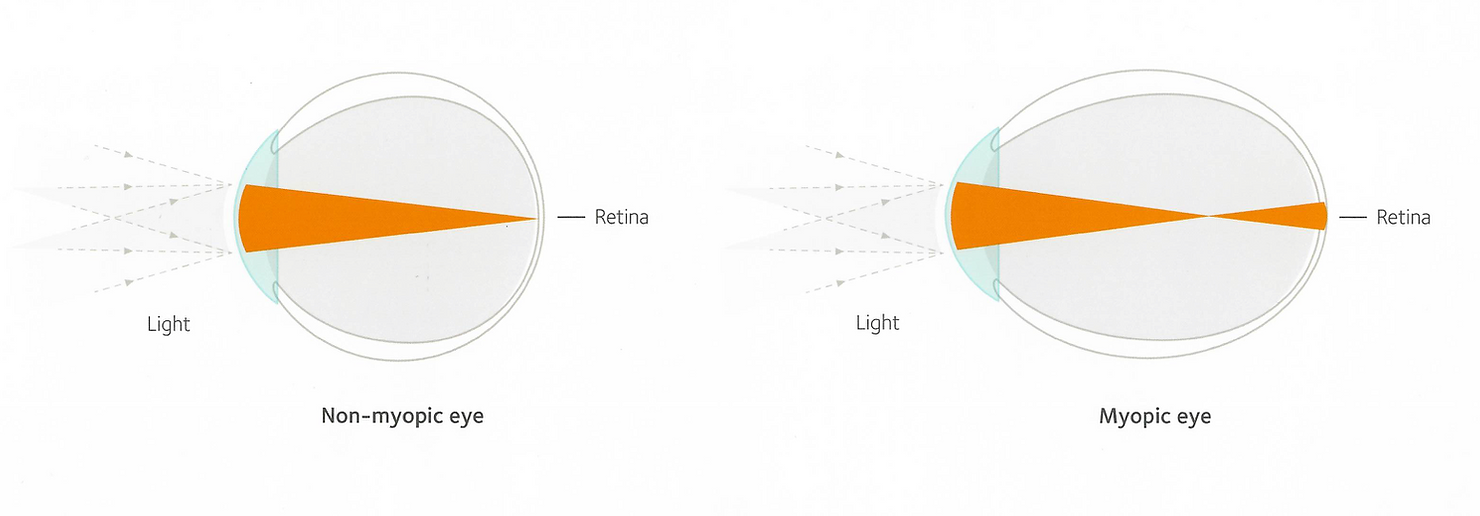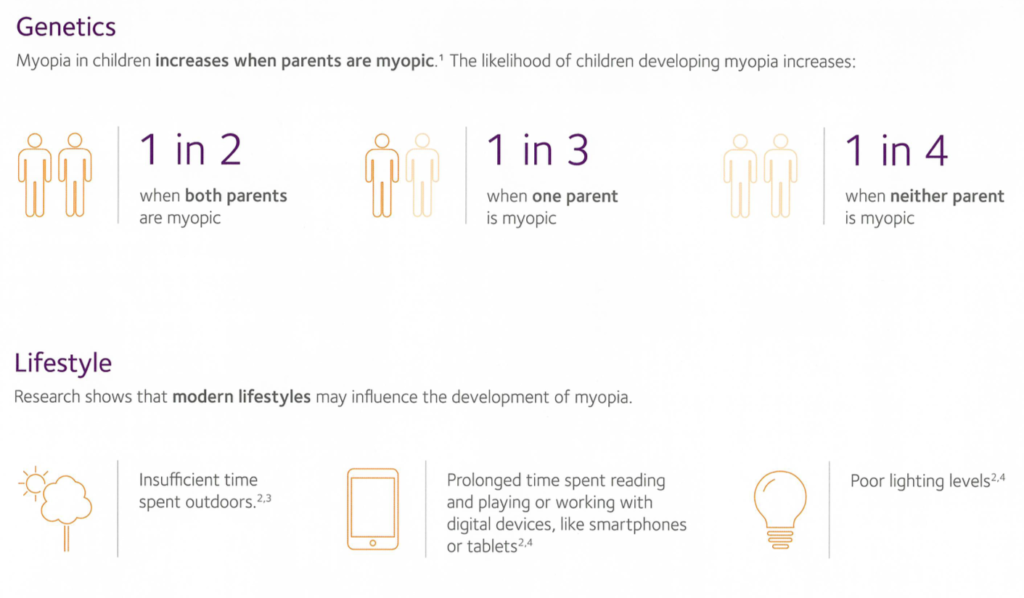n this post we’re going to highlight just how common it is to have myopia and some of the things that cause a child to be nearsighted. Stay to the end and we’ll go over a few of the treatments to slow the progression of myopia . Until recently, your eye doctor didn’t have much to offer that could slow down how fast a child’s eyes get worse. The last few years have been exciting and now eye doctors have several ways to slow down the progression.
If you’re interested to know if your child is a candidate for myopia control, our eye doctors at The Eye Studio YXE offer no-commitment consultations. Book an appointment with us here.
To translate medical-ese to English, myopia means nearsightedness. That is to say that if you’re nearsighted you can see up close but cannot see objects clearly at a distance. You are nearsighted if the first number in your glasses prescription is a negative number. (Watch this video on Instagram for an explanation of how to read your glasses prescription)
Nearsightedness occurs when the eye has grown to be too long. Light rays naturally come to a focus before they reach the retina at the back of your eye. Because the light rays came to a focus too soon, by the time they get to the retina, they are out of focus, making your vision blurred. To make the vision clear, eye doctors use glasses, contact lenses, or laser eye surgery to correct the path of the light rays, so they become focused on the retina.

If you are nearsighted, you’re not alone! Myopia is one of the most common conditions us eye doctors see in our practices. What’s crazy is how so many people are becoming nearsighted so fast. In the early 2000s in North America, 2-3 out of 10 people were myopic. Now that number has increased to 4-5 out of 10(1)!
Myopia is caused by many factors that work together and result in the eye growing too long too fast. Genetics play a big part, and the chances of becoming nearsighted increase if one or both of your parents are nearsighted. Interestingly, the chances of myopia also go up when children do not spend enough time outdoors. (Although, it’s pretty hard to spend enough time outdoors during our cold Saskatchewan winters!)

The progressive worsening of your eyes is frustrating for you and for your eye doctor. If you ask somebody that’s nearsighted, they will probably tell you that they first got glasses when they were in elementary school. Then over the years, their eyes got worse and worse. Their eye doctor would update their prescription, and things would be better for a while, but not before long they would be back for another update.
If the degree of your myopia is too great, very thick lenses are required to provide clear vision. But, thick glasses lenses aren’t the only concern if you’re nearsighted. As the eye grows too long, the tissues and structures inside the eye become stretched. Stretching caused by increased myopia is associated with increased chances of damage to the back of the eye. The damage presents as potentially blinding eye conditions such as myopic macular degeneration, retinal detachment, or glaucoma. The table below shows the risk of these illnesses based on the degree of myopia(2,3).
| | -2.00 | -5.00 | -8.00 |
| Myopic Macular Degeneration | 2.2x Higher | 40.6x Higher | 128.6x Higher |
| Retinal Detachment | 3.1x higher | 9.0x higher | Higher |
| Glaucoma | 2.1 | 3.2 | 5.5 |
Eye doctors didn’t have much to offer other than a new glasses prescription. If you do some google searching, you’ll find stories and videos of people doing home remedies to strengthen their eyes. A lucky few enjoyed some success and no longer need glasses or contacts, but these treatments just don’t work for the most part and aren’t backed by any proper clinical studies.
There is a lot of wrong information about myopia control out there. Some recommendations, when studied, were found to increase the degree of myopia. Not only that, there are recommendations to under-correct myopia while doing visual therapy or exercises. Not only that, under-correcting myopia puts your child at risk of poor school performance, physical danger during activities, or social delays due to the inability to see clearly. Visual therapy and exercises do not have peer-reviewed research proving their effectiveness.
There have been some exciting developments within the last few years, and now eye doctors have several options for reducing how fast the myopia prescription is worsening. The best part is they’re all backed by high-quality scientific evidence.
Here are the options:
- Daytime Soft Contact Lenses
- Night lenses
- Eye Drops
- Peripheral Defocus Glasses (e.g. MiyoSmart or MyoVision)
Each one of these methods has its pros and cons. Talk to your eye doctor to help you navigate the options and decide which one is most appropriate. Let’s do a brief overview of the options together.
Daytime Contact Lenses (e.g. MiSight, Abiliti)
These are soft contact lenses that your child wears during the day. The lenses are taken out to sleep. Clinical trials showed that children wearing these lenses for 10 hours a day, 6 days a week, had less than half the progression of the control group(4). The three-year study included children aged 8 to 12 years old. At first, it seemed like these kids were too young to wear contacts. Still, the researchers kept a careful watch throughout the study. The kids could confidently insert and remove the lenses on their own after one month. There were no serious adverse events such as eye infections. Daytime contact lenses have FDA and Health Canada approval for slowing myopia progression.
The eye doctors at The Eye Studio YXE are certified to fit these MiSight contact lenses.
Night Lenses (a.k.a. OK lenses, Ortho-K)
Different from daytime contact lenses, these lenses are contact lenses worn overnight while your child sleeps. The significant advantage of night lenses is that the vision is corrected without glasses or contacts during the day. Wearing night lenses becomes part of the bedtime routine, just like brushing your teeth.
These lenses are an excellent idea for the athletes out there because there is no chance of losing a lens or breaking glasses. Everything to do with the lenses is taken care of at home. Adults with myopia can even wear these contact lenses as a non-surgical alternative to laser eye surgery.
Dr. Prete is certified to fit night lenses for children with myopia.
Eye Drops (Low-Dose Atropine)
Some eye doctors prescribe a low dose of a medication called atropine. The child is given the eye drop once every day, and they continue with their regular glasses or contacts. The advantage of eye drops is that they can be combined with other myopia management options. Some small preliminary studies show combining multiple myopia treatments is effective for the children that have fast progressing myopia(5).
Peripheral Defocus Glasses (e.g. MiyoSmart, MyoVision)
Lastly, there are particular types of glasses lenses that have been shown to slow down myopia progression. Every major lens company has a version of this product and has shown varying success degrees. These glasses are perfect for kids that are too young for contact lenses. They’re also a good option if your child struggles to have drops or contacts put on their eyes or if you’re generally not interested in contact lens or medicine options.
The Eye Studio YXE is a certified provider of the Hoya MiyoSmart glasses lenses for myopia control. In the clinical trials for the MiyoSmart lenses, the children wearing the myopia control glasses had 60% less progression than the children with regular glasses. Even more, 1 out of 5 children with the MiyoSmart lenses did not have any progression over 2 years(6).
We’re excited to finally have options! And all of the options we have are excellent at slowing down those prescription changes for the nearsighted kiddos out there. It’s worthwhile having a talk with your eye doctor to see what option might be best for you. The doctors at The Eye Studio YXE offer no-commitment consultations so you can find out the options
Links to References:
- Holden BA, Fricke TR, Wilson DA, Jong M, Naidoo KS, Sankaridurg P, Wong TY, Naduvilath TJ, Resnikoff S, Global Prevalence of Myopia and High Myopia and Temporal Trends from 2000 through 2050, Ophthalmology. 2016;123(5):1306-1042.
- Xu L, Wang Y, Wang S, Wang Y, Jonas JB. High myopia and glaucoma susceptibility the Beijing Eye Study. Ophthalmology. 2007 Feb;114(2):216-20. doi: 10.1016/j.ophtha.2006.06.050. Epub 2006 Nov 21. PMID: 17123613.
- Chen SJ, Cheng CY, Li AF, Peng KL, Chou P, Chiou SH, Hsu WM. Prevalence and associated risk factors of myopic maculopathy in elderly Chinese: the Shihpai eye study. Invest Ophthalmol Vis Sci. 2012 Jul 24;53(8):4868-73. doi: 10.1167/iovs.12-9919. PMID: 22743322.
- Chamberlain P, Peixoto-de-Matos SC, Logan NS, Ngo C, Jones D, Young G. A 3-year Randomized Clinical Trial of MiSight Lenses for Myopia Control. Optom Vis Sci. 2019 Aug;96(8):556-567. doi: 10.1097/OPX.0000000000001410. PMID: 31343513.
- Kinoshita N, Konno Y, Hamada N, Kanda Y, Shimmura-Tomita M, Kakehashi A. Additive effects of orthokeratology and atropine 0.01% ophthalmic solution in slowing axial elongation in children with myopia: first year results. Jpn J Ophthalmol. 2018 Sep;62(5):544-553. doi: 10.1007/s10384-018-0608-3. Epub 2018 Jul 4. PMID: 29974278.
- Lam CSY, Tang WC, Tse DY, Lee RPK, Chun RKM, Hasegawa K, Qi H, Hatanaka T, To CH. Defocus Incorporated Multiple Segments (DIMS) spectacle lenses slow myopia progression: a 2-year randomised clinical trial. British Journal of Ophthalmology. Published Online First: 29 May 2019. doi: 10.1136/bjophthalmol-2018-313739

